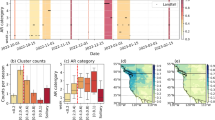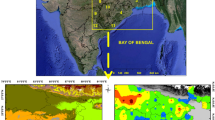Abstract
Understanding local precipitation patterns is essential to water resource management and flood mitigation. Precipitation patterns can vary in space and time depending on factors from different spatial scales such as local topographical changes and macroscopic atmospheric circulation. This study applied the two-stage classification method to distinguish the space–time patterns of local precipitations in the two identified distinct synoptic conditions, i.e. summer and autumn, from 24 gauges during 1996–2008 in Yilan County, Taiwan. The proposed method classifies the synoptic and local conditions for the space–time rainfall patterns by using K-means coupled with empirical orthogonal function analysis, and hierarchical ascending clustering method respectively. The proposed two-stage classification method considers not only the magnitude and the space–time distribution of rainfall events, but also the associated synoptic conditions. The results identified three primary patterns of extreme and two patterns of normal events in both seasons. Regarding the extreme events from typhoons, wind directions and the frontal accompanied effect are major contributors to the magnitude and spatial distribution of rainfall events in the summer and autumn, respectively. Spatiotemporal covariance structures are used to characterize the variability of normal events, showing the increasing frequency of wide spatial and temporal ranges from the summer to autumn. In summary, the proposed classification analysis provides patterns associated with distinct underlying physical mechanisms and space–time characteristics. The general characteristics of rainfall patterns can provide insights for the hydrological modeling of local catchments under different climatic scenarios.












Similar content being viewed by others
References
Baldwin ME, Kain JS, Lakshmivarahan S (2005) Development of an automated classification procedure for rainfall systems. Mon Weather Rev 133(4):844–862
Beven KJ, Hornberger GM (1982) Assessing the effect of spatial pattern of precipitation in modeling stream flow hydrographs. J Am Water Resour Assoc 18(5):823–829
Buytaert W, Celleri R, Willems P, De Bievre B, Wyseure G (2006) Spatial and temporal rainfall variability in mountainous areas: a case study from the south Ecuadorian Andes. J Hydrol 329(3–4):413–421
Cararmelo L, Orgaz MDM (2007) A study of precipitation variability in the Duero Basin (Iberian Peninsula). Int J Climatol 27(3):327–339
Cassano EN, Lynch AH, Cassano JJ, Koslow MR (2006) Classification of synoptic patterns in the western Arctic associated with extreme events at Barrow, Alaska, USA. Clim Res 30(2):83–97
Cerlini PB, Emanuel KA, Todini E (2005) Orographic effects on convective precipitation and space-time rainfall variability: preliminary results. Hydrol Earth Syst Sci 9(4):285–299
Chaubey I, Haan CT, Grunwald S, Salisbury JM (1999) Uncertainty in the model parameters due to spatial variability of rainfall. J Hydrol 220(1–2):48–61
Chen CS, Chen YL (2003) The rainfall characteristics of Taiwan. Mon Weather Rev 131(7):1323–1341
Chen TC, Yen MC, Hsieh JC, Arritt RW (1999) Diurnal and seasonal variations of the rainfall measured by the automatic rainfall and meteorological telemetry system in Taiwan. Bull Am Meteorol Soc 80(11):2299–2312
Chen SM, Wang YM, Tsou I (2013) Using artificial neural network approach for modelling rainfall-runoff due to typhoon. J Earth Syst Sci 122(2):399–405
Cheng JD, Lin LL (1992) A study of the origins, characteristics and determination methods of peak flows for upstream watersheds in Taiwan. J Chin Soil Water Conserv 23(2):29–39
Cheng KS, Lin YC, Liou JJ (2008) Rain-gauge network evaluation and augmentation using geostatistics. Hydrol Process 22(14):2554–2564
Christakos G, Serre ML (2000) BME analysis of particulate matter distributions in North Carolina. Atmos Environ 34:3393–3406
Corte-Real J, Qian B, Xu H (1998) Regional climate change in Portugal: precipitation variability associated with large-scale atmospheric circulation. Int J Climatol 18(6):619–635
ElKadi AK, Smithson PA (1996) An automated classification of pressure patterns over the British Isles. Trans Inst Br Geogr 21(1):141–156
Fang XQ, Kuo YH (2013) Improving ensemble-based quantitative precipitation forecasts for topography-enhanced typhoon heavy rainfall over Taiwan with a modified probability-matching technique. Mon Weather Rev 141(11):3908–3932
Faurès J-M, Goodrich DC, Woolhiser DA, Sorooshian S (1995) Impact of small-scale spatial rainfall variability on runoff modeling. J Hydrol 173(1–4):309–326
Goodess CM, Palutikof JP (1998) Development of daily rainfall scenarios for southeast Spain using a circulation-type approach to downscaling. Int J Climatol 18(10):1051–1083
Goovaerts P (2000) Geostatistical approaches for incorporating elevation into the spatial interpolation of rainfall. J Hydrol 228(1–2):113–129
Haberlandt U (2007) Geostatistical interpolation of hourly precipitation from rain gauges and radar for a large-scale extreme rainfall event. J Hydrol 332(1–2):144–157
Hussain I, Spöck G, Pilz J, Yu H-L (2010) Spatio-temporal interpolation of precipitation during monsoon periods in Pakistan. Adv Water Resour 33(8):880–886
Jackson IJ, Weinand H (1995) Classification of tropical rainfall stations—a comparison of clustering-techniques. Int J Climatol 15(9):985–994
Kitchen M, Blackall RM (1992) Orographic rainfall over low hills and associated corrections to radar measurements. J Hydrol 139(1–4):115–134
Kulkarni A, Kripalani RH, Singh SV (1992) Classification of summer monsoon rainfall patterns over India. Int J Climatol 12(3):269–280
Lana X, Martinez MD, Serra C, Burgueno A (2004) Spatial and temporal variability of the daily rainfall regime in Catalonia (northeastern Spain), 1950–2000. Int J Climatol 24(5):613–641
Lee YH, Yang HD, Chen CS (2012) Spatial risk assessment of typhoon cumulated rainfall: a case study in Taipei area. Stoch Environ Res Risk Assess 26(4):509–517
Lin GF, Chen LH (2005) Application of an artificial neural network to typhoon rainfall forecasting. Hydrol Process 19(9):1825–1837
Lin GF, Chen GR, Wu MC, Chou YC (2009) Effective forecasting of hourly typhoon rainfall using support vector machines. Water Resour Res 45(8):W08440. doi:10.1029/2009WR007911
Lin GF, Jhong BC, Chang CC (2013) Development of an effective data-driven model for hourly typhoon rainfall forecasting. J Hydrol 495:52–63
Lu HS (1999) Rainfall depth-duration-frequency relationships and design storm distributions of different durations for the Lienhuachih Area of Central Taiwan. Taiwan J For Sci 14(1):63–76
Martinez MD, Lana X, Burgueno A, Serra C (2007) Spatial and temporal daily rainfall regime in Catalonia (NE Spain) derived from four precipitation indices, years 1950–2000. Int J Climatol 27(1):123–138
Michaelides S, Pattichis CS, Kleovoulou G (2001) Classification of rainfall variability by using artificial neural networks. Int J Climatol 21(11):1401–1414
NOAA/ESRL (2010) Daily Mean Composites. http://www.esrl.noaa.gov/psd/data/composites/day/. Accessed on 01 Aug 2010
Olea RA, Jian X, Yu YS (2006) Semivariogram modeling by weighted least squares (vol 22, p 387, 1996). Comput Geosci 32(3):419
Penarrocha D, Estrela MJ, Millan M (2002) Classification of daily rainfall patterns in a Mediterranean area with extreme intensity levels: the Valencia region. Int J Climatol 22(6):677–695
Philipp A, Bartholy J, Beck C, Erpicum M, Esteban P, Fettweis X, Huth R, James P, Jourdain S, Kreienkamp F (2010) Cost733cat—a database of weather and circulation type classifications. Phys Chem Earth Parts A/B/C 35(9):360–373
Romero R, Sumner G, Ramis C, Genovés A (1999) A classification of the atmospheric circulation patterns producing significant daily rainfall in the Spanish Mediterranean area. Int J Climatol 19(7):765–785
Singh KK, Singh SV (1996) Space-time variation and regionalization of seasonal and monthly summer monsoon rainfall of the sub-Himalayan region and Gangetic plains of India. Clim Res 6(3):251–262
Skaugen T (1997) Classification of rainfall into small- and large-scale events by statistical pattern recognition. J Hydrol 200(1–4):40–57
Vrac M, Hayhoe K, Stein M (2007a) Identification and intermodel comparison of seasonal circulation patterns over North America. Int J Climatol 27(5):603–620
Vrac M, Stein M, Hayhoe K (2007b) Statistical downscaling of precipitation through nonhomogeneous stochastic weather typing. Clim Res 34(3):169–184
Wang S-T, Chao Y-K (1984) Natural seasons of the weather in the Taiwan area (in Chinese with English abstract). Atmos Sci 9:125–146
Ward JH (1963) Hierarchical grouping to optimize an objective function. J Am Stat Assoc 58(301):236
Yu HL, Wang CH (2010) Retrospective prediction of intraurban spatiotemporal distribution of PM2.5 in Taipei. Atmos Environ 44(25):3053–3065
Zagouras A, Argiriou AA, Flocas HA, Economou G, Fotopoulos S (2012) An advanced method for classifying atmospheric circulation types based on prototypes connectivity graph. Atmos Res 118:180–192
Zhu J, Kau W-S, Hsu H-H (2002) Review of precipitation variation in Taiwan—relationships among precipitation, synoptic classification, and East-Asia circulations (in Chinese). J Global Chang Newsl 9(36):28–37
Acknowledgments
This research is supported by grants from the Ministry of Science and Technology of Taiwan (NSC101-2628-E-002-017-MY3 and NSC102-2221-E-002-140-MY3) and the Central Weather Bureau of Taiwan (MOTC-CWB-99-2M-10). We would also like to thank Cheng-Kan Wang and Tu-Je Chang for their initial implementations of the data analysis.
Author information
Authors and Affiliations
Corresponding author
Electronic supplementary material
Below is the link to the electronic supplementary material.
Rights and permissions
About this article
Cite this article
Yu, HL., Chen, BL., Chiu, CH. et al. Analysis of space–time patterns of rainfall events during 1996–2008 in Yilan County (Taiwan). Stoch Environ Res Risk Assess 29, 929–945 (2015). https://doi.org/10.1007/s00477-014-0928-x
Published:
Issue Date:
DOI: https://doi.org/10.1007/s00477-014-0928-x




